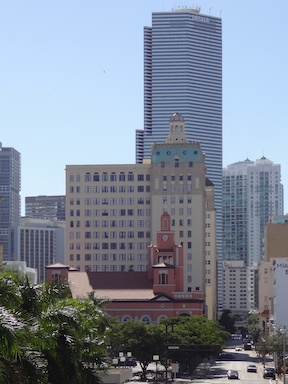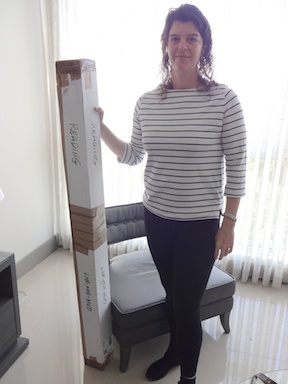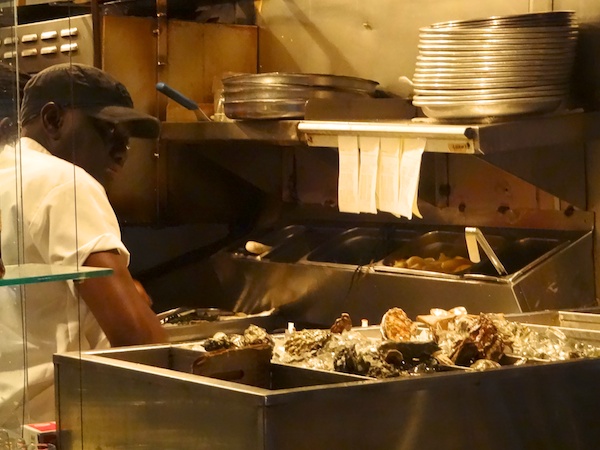We were late for the airport, thanks to an idiot pre-booked taxi driver who hadn’t bothered to research his pick-up address. However, we weren’t too concerned because we’d already checked in online and just had to drop off our luggage.
We’d deliberately flown American Airlines because their allowance is two 32kg pieces each, and we had a lot of tools and decorating equipment to take with us to Uruguay, including a roll of specialised frosting film that we intended to use on our windows. At first, the check-in ladies reckoned that we could only take a single piece each, but that misunderstanding was swiftly cleared up because Bronwyn knows her small print. Then, just as our luggage stickers were being printed, the lady said “Isn’t there a box embargo on this flight?”
We were beginning to suspect a conspiracy. The US government had already done its level best to prevent us from paying for our container shipment (see previous blog), and now they were randomly instituting a rule against our box of window film.
This “embargo” wasn’t mentioned anywhere even in the very small print of our tickets, which we had read very thoroughly because our box was only one centimetre short of the maximum length for American Airlines luggage. We encouraged the flight staff to check in more detail. Eventually it emerged that while there was indeed a “box embargo” on American Airlines flights out of our stopover destination Miami, the rule did not apply to flights into Miami. Our bemused but helpful assistant agreed to check in our box for the first leg, as long as we promised to repack the box into a bag in Miami, as apparently this would satisfy the regulations.
We had a pleasant flight, and no trouble with Miami Customs, especially as we got to bypass the enormous queues of US citizens’ waiting to use their “streamlined” automated gates. Instead we ambled up to the “foreigners” exit where a cheerful young man stamped us through without any delay. Our box was even waiting for us on the baggage carousel.
There was a dicey moment at the airport Left Luggage office when the rude attendant demanded to see our boarding card before he accepted our luggage. Who keeps their boarding card after getting on a long-haul flight? Luckily Bronwyn found hers screwed up amongst the empty food wrappers in her bag. We dropped our other three bags of tools and made our way to the Miami metro system with two small carry-on bags and a one-and-a-half metre box over my shoulder.
We found ourselves unable to decipher the metro map, but were helped by a friendly transit cop who showed us where we needed to go. He then accompanied us to the ticket machine, which didn’t accept notes larger than $20, something of a problem because all of our currency was in a paper bag full of hundreds (see previous blog). The machine supposedly accepted credit cards, but not without a numeric US ZIP code, so we couldn’t get it to accept our foreign cards. The nice guard spent a lot of time trying to find a US postal code that would work with our cards, or to get it to accept a truncated foreign post code, but in the end he reasoned that if the system was too stupid to let us buy a ticket then we might as well ride for free, and waved us through the barrier.


Out with the old 
In with the little boxes

Miami streets from the elevated train 
The box arrives in Miami
After delivering the box to our hotel room, we took a long bus ride to the waterfront and enjoyed a stroll, a paddle and a nap on Miami Beach.

We had pre-booked a late dinner at the excellent River Oyster Bar, reasoning that if we ate really late after lying in the sunshine we would reset our body clocks. The food and the ambience were wonderful, and we whiled away the hours over salt-encrusted bronzino, grilled mahi-mahi and excellent local wines, before returning to the hotel and sinking into a deep and satisfying sleep.
On Sunday we woke with a whole day to tackle the problem of finding a bag for our oversize box. The tourist shops only held expensive regular-sized rolling luggage, but while exploring some of the poorer Spanish-speaking quarters of the city, we eventually came across a little shop that carried simple nylon bags. The helpful lady located her largest bag, technically 50 inches, for just 20 dollars.
With that job out of the way, we returned to the River Oyster Bar for a happy-hour feast of oysters, locally caught cobia, and wine.

We headed back to the hotel, and found that even though the roll would probably almost fit inside, there was no way of getting it through the mouth of the bag. We knew from our original architectural plans that our film was oversized for the windows that we were going to fit it to, so we borrowed a pair of scissors from the bemused receptionist and shortened the roll until it fit.
Finally we grabbed a taxi to the airport, had no trouble checking in our box-in-a-bag, and enjoyed a relatively comfortable red-eye flight to Montevideo.
On our arrival in Uruguay, we quickly made our way through Customs and down to the baggage hall. We found our new bag patiently circling on the carousel, and to our complete lack of surprise, noted that it was sitting amidst a plethora of cardboard boxes of all shapes and sizes. “Box embargo”, indeed.